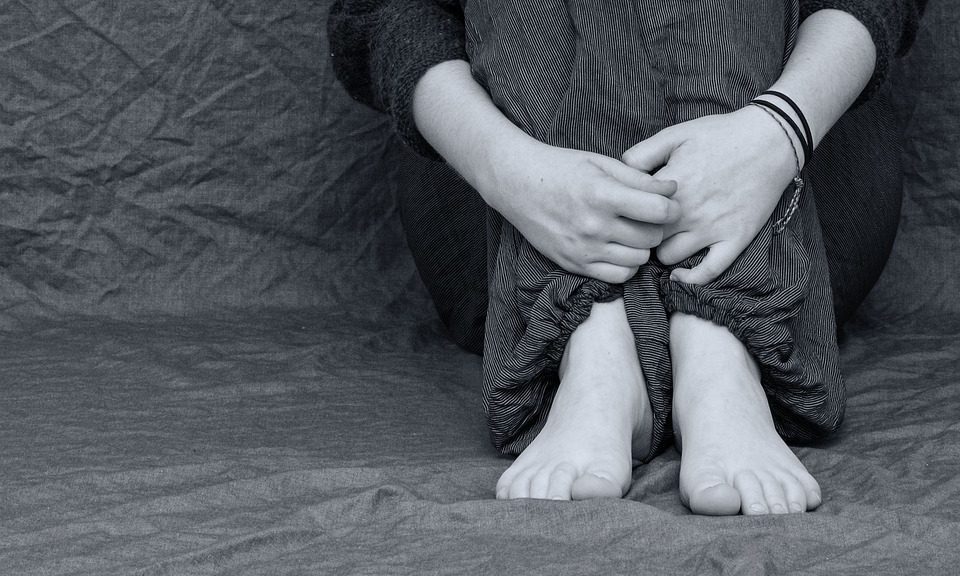By Madelyn Swenson
I am the one in five.
The one in five girls who will be sexually assaulted as a child.
I was 14. It was a cool summer day. My grandma — my dad’s mom — and her boyfriend were coming for dinner.
My grandpa died before I was born so my grandma’s boyfriend, Wallie, was my grandpa.
That changed in a matter of minutes.
I asked Wallie to come downstairs to get measurements for a shelf he was making me for my new room.
As we were walking out of the room to go upstairs, he pulled me in for a hug.
I hated hugging him.
He pulled out of the hug and brushed my breasts, like he always did.
I turned to walk away, and he pulled me in from behind and started to feel me up.
I froze.
I did not know what to do.
Suddenly, I tried to move to go upstairs.
But he held me in place and whispered in my ear.
“Just one more feel.”
I said, “No,” meekly and forced his hands off me and ran upstairs.
I kept quiet all through dinner and ice cream.
It was not till my mom called me that night and asked how my day was that I broke down.
She asked where my dad was, in her worried mom way.
I left my room to go get him. I handed him the phone, tears running down my face.
I still remember his face. Astonished and worried.
It is a face I will never forget.
Along with my grandma’s face when we told her.
I blamed myself.
I still do.
Sadly, I am not the only child that has to go through this. I did not even experience the worst of it.
According to Victims of Crime, which is the lead advocacy organization for victims of crime, one in five girls and one in 20 boys will face this while they are still a child.
“Three in four children will know their attacker,” Victims of Crime stated.
Eunie Alsaker, a counselor at Winona State, explained the process she goes through with survivors to help them heal.
She explained that she first teaches a survivor how to calm their muscles and slow their breathing when they start to go into fight or flight mode.
Yoga and meditation are two activities Alsaker normally recommends. This also helps a survivor to feel safe and balanced.
Alsaker explained that the process of healing after an assault is not a fast process.
“It can take years. It can often result in some anxiety, some fears. It can disrupt relationships with family members,” Alsaker explained. “Usually, trust (issues) is a very frequent response. You kind of have to learn who is trustworthy.”
I have experienced many of the above.
I am terrified of old men and beards.
I have a hard time in relationships because I am jumpy whenever a partner hugs me.
Alsaker continued by explaining that there are sights, smells and more that can trigger a survivor.
I know how that feels first hand.
When I see a green pickup with the bed covered, an old man with a scruffy white beard, when a male hugs me or when Arizona is mentioned, I feel a catch in my throat.
My heart speeds up.
I am suddenly that terrified 14-year-old girl again.
Just as Alsaker said, the only way I can come back to the present is by taking a deep breath and reminding myself where I am and that he is not here.
Another coping mechanism Alsaker suggests is self-care. Many survivors have a hard time sleeping, finding safe places, participating in hobbies and finding good people to be around during the healing process.
She also says that a lot of therapy is focused around normalizing the self-blame aspect that so many survivors suffer from.
I know that I still do this.
I still blame myself for hurting my grandma.
I know it’s not my fault, but that thought does not matter.
Heather Gerdes, gender-based violence intervention and prevention coordinator, explained ways of preventing an assault.
She said the campus RE Initiative pushes bystander intervention. She explained that it is mostly just being aware of your surroundings.
“When in doubt call 911,” explained Gerdes.
She also explained her belief that educating everyone on what consent is will be extremely beneficial in the long run.
Gerdes does believe that the culture is changing but that there is a lot of work to do.
“I do see the start of a culture that is changing,” Gerdes explained. “However, that comes with a lot of work.”
Like many, I am still healing six years later. I still get nervous around older men, pickups, hugs and the mention of Arizona.
However, I spoke up. He served deserved jail time. I do not know how much time. I did not want to know.
I can help to bring awareness to this horrid issue. I can help both children and adults.
I am the one in five.
I blamed myself.
I still do.
Madelyn Swenson is a junior majoring in mass communication-journalism at Winona State University. She is the news editor of the Winonan, the Winona State student newspaper, the president of the Society of Colligate Journalists and a DJ on the student radio station KQAL. In her free time, Madelyn likes to watch Netflix, hang out with friends and family, and read. Madelyn hopes to be an investigative reporter at a major news outlet.
